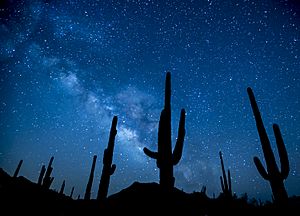Sonoran Desert National Monument facts for kids
Quick facts for kids Sonoran Desert National Monument |
|
|---|---|
 |
|
| Location | Maricopa County & Pinal County, Arizona, USA |
| Nearest city | Phoenix, AZ |
| Area | 496,400 acres (200,886 ha) |
| Established | January 17, 2001 |
| Governing body | U.S. Bureau of Land Management |
| Website | Sonoran Desert National Monument |
The Sonoran Desert National Monument is a special protected area in Arizona, USA. It is located south of Goodyear and Buckeye, and east of Gila Bend, Arizona. This monument was created on January 17, 2001, by a special order from the President.
The monument covers about 496,400 acres, which is like 775 square miles. It is managed by the U.S. Bureau of Land Management (BLM). The BLM helps protect important natural and historical places. Even though the BLM already looked after these lands, making them a "National Monument" gives them even more protection.
The Sonoran Desert National Monument protects a small but important part of the larger Sonoran Desert. The Sonoran Desert is huge, covering about 120,000 square miles. It stretches into California and Mexico. The monument includes areas like the North Maricopa Mountains, South Maricopa Mountains, and the Table Top Wilderness. These areas are home to many different desert plants and animals.
Why the Monument Was Created
The Sonoran Desert National Monument was officially created by a special order called a "proclamation." This order was signed by President Clinton in 2001. The proclamation explained why this area needed to be protected.
President Clinton described the monument as a wonderful example of the Sonoran Desert. He said it has an amazing variety of plants and animals. It also has many important historical sites. These sites include ancient rock art, places where tools were made, and other old artifacts.
The Sonoran Desert is known for having the most different types of living things among all the deserts in North America. This makes it a very special place for scientists to study.
Protecting the Land
The proclamation that created the monument also talked about how to protect it. It mentioned that some activities, like livestock grazing, could affect the monument's natural features. The order said that grazing permits in some areas would end. This helps make sure the land stays healthy for all the plants and animals.
The monument is also home to several species that are listed as endangered. This means they are at risk of disappearing forever. Protecting this land helps these special animals and plants survive.
Images for kids




